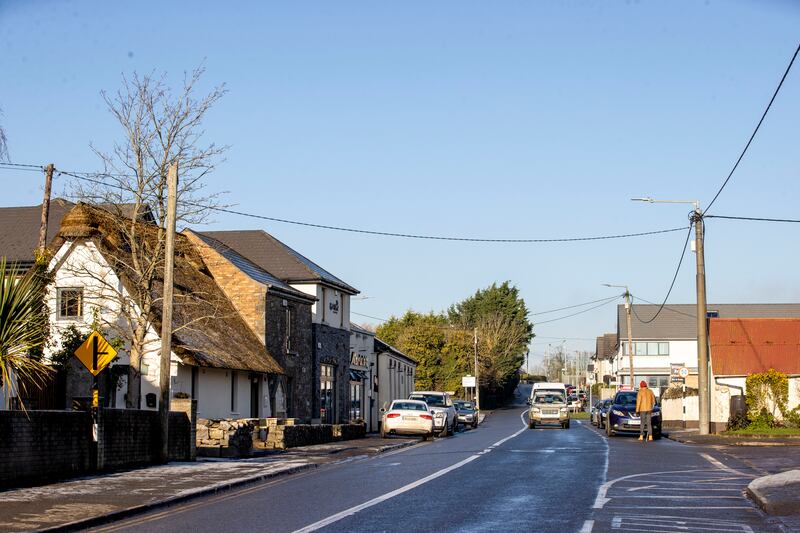Sitting outside on his patio in Ballyboughal, Tom Quinn can clearly make out planes taking off from Dublin Airport’s north runway, which began operating last summer.
As they approach, he watches them climb before banking sharply to their right, eventually passing directly overhead, the kind of flight path never expected by many of those living beneath.
“You hear it in the distance. It gets louder and louder and it flies directly over the house,” says Quinn. “As it goes off into the distance the noise is carried back as well. For each flight ... there is about five minutes of noise.”
Others living around Ballyboughal, a small village about a 20-minute drive from the airport with a population of around 1,000 people, tell similar stories. Since the opening of the north runway, a €320 million piece of infrastructure first granted planning permission in 2007, it has brought daily unwelcome disruption.
Now there is something else for the community to worry about. This January, An Bord Pleanála will publish its decision on whether to allow extra traffic to run from the airstrip, over longer hours including through the night.
Earlier this year, households began to notice an increase in what they describe as relatively low-flying aircraft and accompanying noise. Frustrated by an apparent sluggishness among various authorities to take complaints or answer questions, the Ballyboughal Community Council began to organise.
A poll conducted among local people through the council’s community alert database pulled in a 30 per cent response rate, amounting to 121 respondents, of whom 78.5 per cent said they had noticed an increase in aircraft noise.
Of those, 17.9 per cent had perceived a small difference while 47.4 per cent, 20 per cent and 14.7 per cent had noticed a significant, large or enormous increase respectively, the last three accounting for over 82 per cent. Nearly 60 per cent felt the noise was having a significant or major impact on their quality of their life.
One participant commented that it was as if the planes were landing in the front garden.
“It sort of dawned on me that this is not what we thought was going to happen,” says David Walton, a council member who has been organising its response and submission to An Bord Pleanála. “It’s like missiles just going overhead incessantly, and really, really loud.”
The residents around Ballyboughal believe the problem lies in the flight paths, but they have struggled to get answers.
As they see it, the planes take off and, soon afterwards, take a sharp right turn – an observation supported by countless images from the Flight Tracker app – before climbing, steeply, above the village.

This often seems to occur beneath 500m, meaning the noise, according to their own unofficial measurements, reaches between 70 and 90 decibels. The nearest official measurement station, they point out, is over 8.5km away.
“We never had an issue with aeroplane noise [before]. Planes do fly over but they would be very high and they wouldn’t bother us,” says Bernard Lynch, an architect who has lived in Ballyboughal for over 20 years. “It’s got to the stage where planes are flying over and myself and my wife – we are avid gardeners – would have to stop talking because it’s impossible to have a conversation ... we feel like we are just collateral damage.”
Acknowledging the issues in a recently circulated email, the DAA, which runs the airport, said it had begun a review of flight paths and that no earlier flights would be permitted until it concluded.
“On commencement of North Runway operations an issue regarding departure flight paths was identified, which resulted in some local communities being unexpectedly overflown, for which DAA sincerely apologises,” it said.
[ Ireland’s growing aviation sector is a cause for concernOpens in new window ]
This followed a message in November from an official at the Aircraft Noise Competent Authority (ANCA), the noise regulator, to a local councillor stating that “flight paths which were provided for in the forecasts given to us and used in our recent regulatory decision (June 2022), are different to those currently in use”.
The DAA review, which is ongoing, has found some of the Instrument Flight Procedures (IFPs), or flight paths, were not aligned to modelling assumptions included in the DAA’s planning submissions. Updated IFPs are now being prepared for use in early 2023. The DAA has said an additional “small” number of homes will now qualify for noise mitigation measures.
The authority declined to comment on community concerns on the basis that its review is ongoing.
A number of questions will be raised on the issue at Monday night’s meeting of Fingal County Council, where a protest by residents from the St Margaret’s Ward area is expected.
[ Noise pollution threatens survival of more than 100 species, study findsOpens in new window ]
Independent councillor Cathal Boland, who has been following the issue in his local constituency, will seek information from council officials.
“What they seem to have done was to get planning permission to build a runway. The intent was to allow a plane to take off in a certain fashion but they aren’t doing that,” he says, adding the current flight path and associated noise was affecting a broad stretch of north county Dublin including Rathcross, Oldtown and Rolestown.
Mr Boland believes it to be a technical problem that is resolvable but said the issue was as much one of communication. “One thing that they should do immediately is be a good neighbour and level with the community,” he said. “If the DAA have a valid case, an understandable case, they should make it to the people.”
ANCA, which regulates aircraft noise levels around Dublin Airport, said it did not have a role in managing complaints or in routing aircraft but that it has plans to position additional monitoring stations in the area, including Ballyboughal, “in the months ahead”.
The Irish Aviation Authority, which does have a role in flight paths, said its Air Navigation Service Provider was involved in the DAA review, but from an air safety standpoint. It said whether current flight paths from the north runway are the same as those originally proposed, or in what circumstances they might change, was a “DAA matter”.
A spokesman said revised plans for Standard Instrument Departures (SIDs) have been submitted but require regulatory approval before they can be implemented.
“Any change will not happen until sometime later in Q1. In the meantime, the continued use of the current SIDs is required.”













